Marketers have shifted their focus from the “one-size-fits-all” approach to being more personal.
Personalization, Especially online personalization, is a medium effort, high return game. According to Gartner, by 2020 companies with the right personalization strategy would see a 15% rise in their revenue. On top of that, 48% of customers expect special treatment from the brands they purchase from.
However, creating the right online personalization requires solid planning and execution. Do it wrong and your customers would avoid you like the plague. In 2017, US brands lost $756 B because of customer mistrust thanks to poor personalization.
So, In this article, I am going to give you a framework for creating website personalization that works.
Interested?
Let’s dive in.
Personalization in 2020: how does it look
First thing first. If you are reading this article, chances are good you are yet to reach a “mature” stage of personalization. In that case, you might want to see some examples of how to do this, right?
Well, here are some examples for you.
Convertkit
Convertkit is an email automation service provider for bloggers, podcasters and anyone who wants to build an email list online. Popular blogger Pat Flynn is a fan Convertkit. He has even published a post about it.
Now, Pat is one of the biggest affiliate marketing influencers and has a loyal following. Convertkit’s marketing team understands Pat’s readers’ trust and values Pat’s words. So, they lead Pat’s readers to this page, instead of Convertkit’s regular home page:
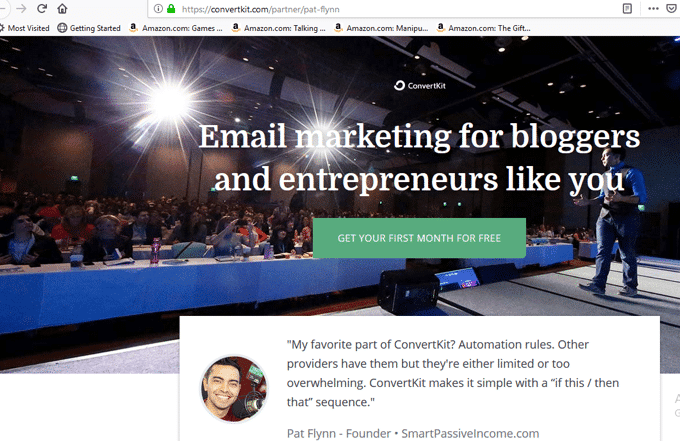
By taking a look at it you can tell this landing page is designed to appeal to Pat’s readers.
ZOHO
Zoho is a SaaS company that offers CRM and office suits. So, SMBs are one of their targeted customer segments.
ZoHo personalize based on user search intent and they take cues from search terms used.
Here is how their landing page looks like for search terms like “CRM for small business” or “SMB CRM”
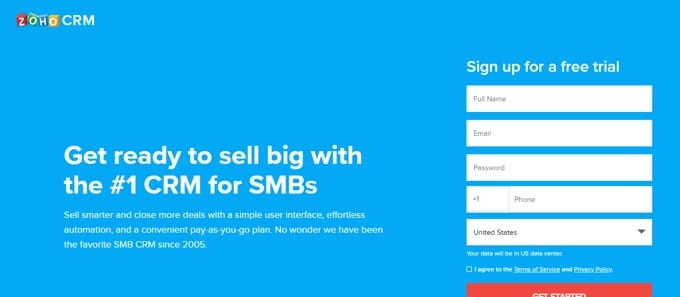
Bombfell
Bombfell is a men’s wear e-commerce store. Interestingly their whole business is based on microlevel personalization. They allow users to pick complete outfits of their own choice.
Here is the survey form on their website for delivering outfits according to users’ tastes.
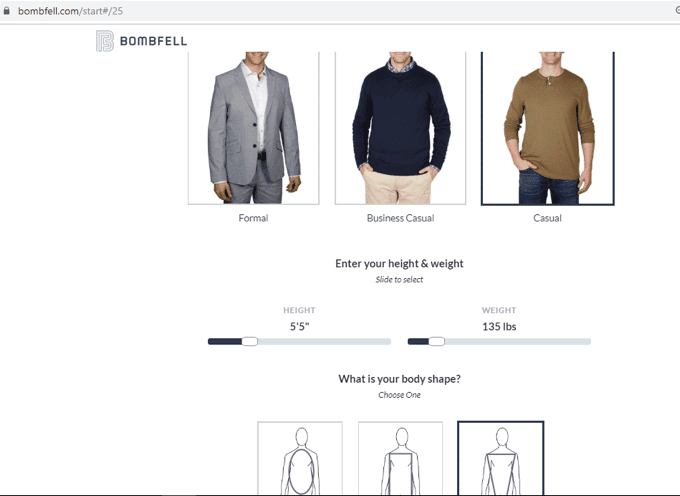
DavidsTea
DavidsTea is a Canada based tea retailer. They do a good job of personalizing emails. Their approach is quite refreshing— they summarize user purchase history in a visually appealing way.
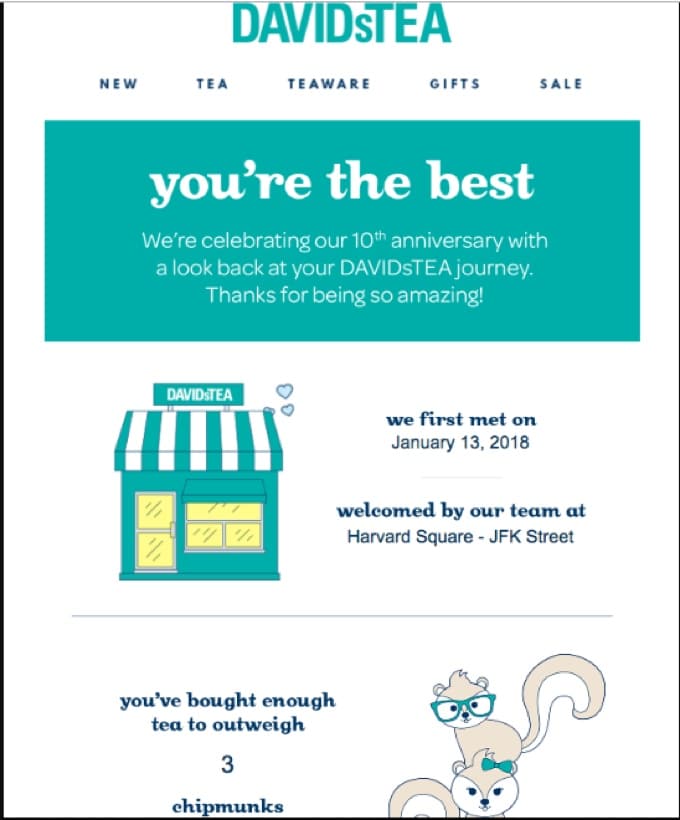
Source: Really Good Emails
The current state of online personalization :
Before we move on to the nitty-gritty of an effective framework let’s have a look at the current state of online personalization.
Let’s start by asking how important is online personalized experience for marketers?
Evergage found out, 74% of marketers believe personalization has a strong impact or extreme influence on improving customer relationships.
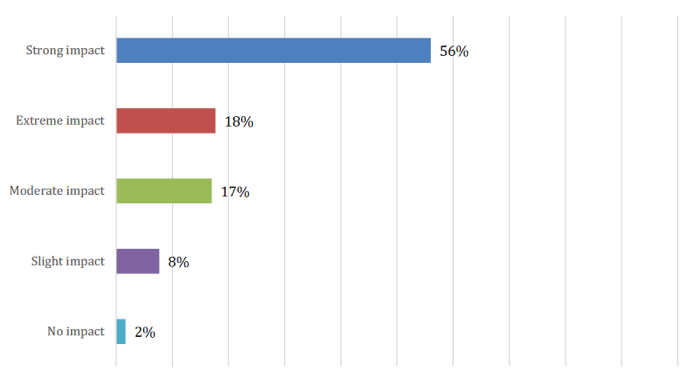
Source: Evergage
And they are right.
Customers do prefer content and offers which fit their interests and tastes.
56% of US-based customers “really” or “somewhat” like to receive personalized messages, another study revealed. 83% of customers are even willing to share their info for a personalized experience.
Customers mostly receive these tailored messages through email and website. According to Statista, 77% of marketers still consider and utilize email as their best personalization medium. Website personalization comes second (52% of marketers) followed by app personalization (32%)
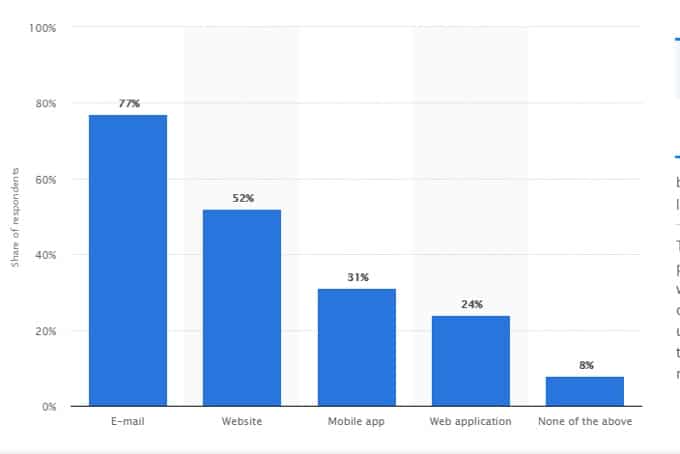
That being said, instead of putting all the eggs in the same basket marketers are turning towards multi-channel personalization. According to recent research by Smarthq, marketers increased their invest in multichannel personalization by 16% in 2018.

However, in spite of all this awareness and investments, marketers still have a long way to go. According to a Periscope By Mckinsey study, only 40% of all “personal messages” actually feel personal.
And marketers are aware that there are scopes of improvement. 38% of them are only moderately satisfied with the effectiveness of current personalization efforts. 18% of them are not satisfied at all.
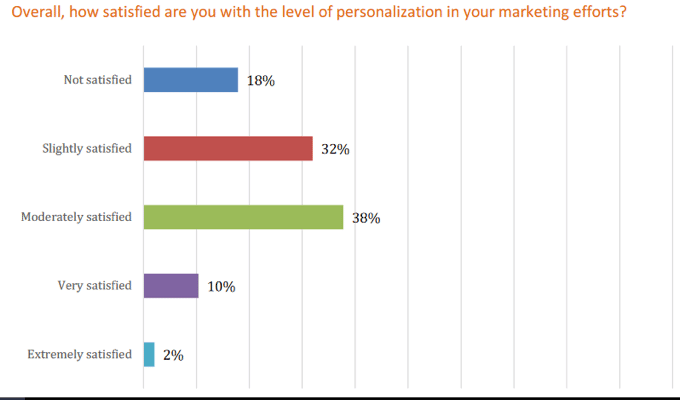
Source: Evergage
Issues with the current state of online personalization
Let me show you two stats:
- 80% of customers prefer brands that provide a personalized experience.
- Yet 75% of customers feel most of the personalized brand messages are somewhat creepy.
Clearly, there is a gap between customers’ expectations and brand messages.
This gap comes into two flavors:
1. Creepy personalization
Many marketers are guilty of crafting super-targeted messages that come off as outright creepy. Make no mistake, marketers have a good intention. They want their audience to find better deals, relevant products and blog posts worth reading. That’s the whole point of personalization after all.
However, sometimes marketers get reckless and use any audience data they can get their hands on. And we get tweets like this:
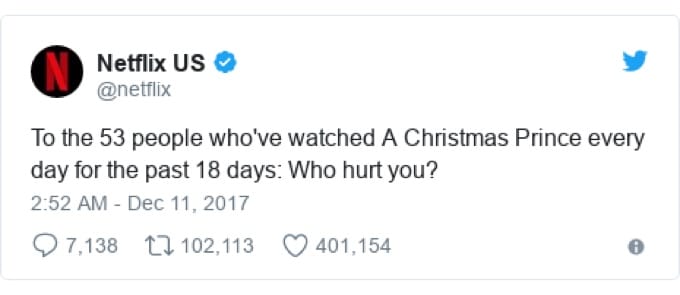
Such invasive content rubs consumers in the wrong way. According to a report by Interactions, customers feel uneasy when an AI system gets access to data which they didn’t provide directly. Customers’ “creep meter” get switched on when:
- Personalized messages use social media data (50%)
- Brands know about their purchase history from other brands.
- Brands keep a tab on other household members’ past interactions with another company.
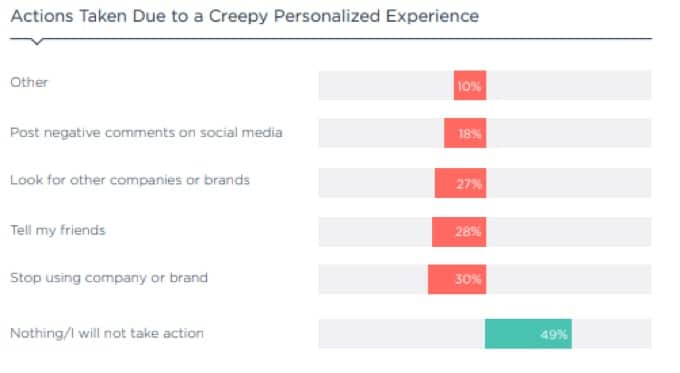
Many brands are guilty of crossing the “creepy line”. And it repels the consumers. According to In moments study, 30% of consumers look for other brands if they get creeped out.
(Inmoment 2018 CX report )
In the case of Netflix, that tweet freaked out everyone. They started questioning about Netflix’s sincerity about protecting user data. In the face of criticism, Netflix had to issue a public apology. Not a desired outcome, isn’t it?
2. Loopholes in audience research:
When a brand asks for personal info, they make promises to deliver a better experience to the users. Unfortunately, many brands insist on gathering too much data ( thanks to cookies) yet deliver little more than poorly targeted advertisements or emails with recipients’ names in the subject line. This may not be as bad as being creepy but the result is the same. Customers sigh and move on. Could you even blame them when they have to endure something like this?

The reason brands fall flat on delivering the right messages is the loophole in audience research. For instance, customers’ willingness to share and “personalization tolerance” may vary. According to a PEW research, 52% of customers are willing to share their personal info to their doctor’s website but only 27% ready to share details with a smart thermostat manufacturing brand.
If brands choke them with targeted messages every week without understanding customers’ tolerance level, they would bailout.
This is just one example. Many creative ideas get tossed to the bin just because brands didn’t take time to know their audience.
If you want to make your personalization effective, make sure to get a solid idea about customers’ habits, expectations and challenges first.
Are you even ready to implement the online personalization strategy
The worst thing a marketer can do is blindingly follow a trend. Before you dip your toes into the murky water of “personalization” you better be sure it is worth it. And it’s pretty easy to find out. All you need to do is answer these questions:
Do you have enough customers?:
You might have to experiment a bit before you find the golden way of offering a personalized experience to your audience. And to run those tests on you need a decent-sized sample— your targeted audience segment.
So in the beginning, building up a customer base should be your priority.
Once you have enough customers, having enough customer data comes next. You would be looking for three types of data:
- Demographic: Your customers’ location, gender, occupation and income range. Do your customers have some specific challenges?
- Behavioral: Behavioral data is all about user intent. How your visitors act after landing on the website reveals their user-intent. For example, if someone spends more time on pricing pages, he has a purchase intent.
- Contextual: Just demographic and behavioral data aren’t enough. The wrong context can sabotage an otherwise creative personalization idea. Take a look at this tweet.

Now the question is, how do you understand the context? Well, things like customer motivation, purchase frequency, product usage, and customer journey position leave clues about where customers are coming from. If you want to know the context, take a look at the above-mentioned factors.
Only after understanding the context, you would have a completely “three-dimensional” idea of what is relevant to customers.
If you think you don’t have enough data yet ( you are not alone, 55% of your peers think the same), start from figuring out what data exactly you need. Afterward, pick the best channels and gather the required data.
Do you have a process for validating your ideas?
Nothing is absolute when it comes to personalization. All those audience segments and targeted messages are just assumptions at first. In the beginning, you would be throwing spaghetti on the wall.
However, to know what works you need a solid process. This process would validate your ideas and reveal the scopes of improvement. If your idea, no matter how creative, doesn’t look good after you validate it, ditch it.
Any effective idea validation process has 4 steps: Goals, hypothesis, experimentation, and validation.
- Goals: The validation process starts with defining your Goal. Write down why you want to offer a personalized experience. Do you want more email signups? Want to convert one time customers from the IT industry into regulars? Try to make your goals as precisely as possible.
- Hypothesis: Once you have goals written, you need testable assumptions. Ideally, a hypothesis comes with a prediction. Do you think an extra discount would make your one time customers come back next time? That’s a hypothesis right there.
- Experimentation: The goal of experimentation is to test your hypothesis in a fast and cheap way. It could be a single test or series of tests. By experimenting you make sure your ideas are worth resource and time investment.
- Validation: Validation separates the wheat from the chaff. If the experimental results show your hypothesis has potential then go ahead and try that idea. Validation doesn’t guarantee success but it turns the odds into your favor.
How to segment your audience:
Before we go deep into the discussion, let me say it: in theory, the segmentation and the personalization aren’t the same. Segmentation is just discovering a group of individuals with a common set of characteristics— locations, preferences, IP addresses, and whatnot. Whereas, personalization is all about tailoring experience on the individual level. In a way, personalization is segmentation taken to the extreme.
However, in practice, offering a super-targeted personalized experience isn’t easy at the beginning. There are just too many variables. Until you reach the point where you know what you are doing, you better stick to a hybrid model where you first segment and then personalize.
The saying “Measure twice, cut once” is applicable in this context. Pick a wrong segment and you would have a hard time delivering the content which fits your audiences’ interests. So before you finalize your segment ask yourself these questions:
- Is this segment unique?
- Are you creating this segment based on the data you gathered?
- Does this segment have a decent number of potential/existing customers?
- Can you solve their problem or delight them?
If you say yes to all these three, then congratulations! You did a good job.
Now, in a broad sense, segments are curved based on three types of profiles: Demographic, Behavioral and psychographic.
- Demographic: This is the most basic type of data on the basis of which you can segment. Point to be noted, basically doesn’t mean low return. If done correctly, demographic segmentation and personalization could pay serious dividends.
As the name suggests, demographic segmentation is based on demographic data like Geolocation, device, age, weather, income and job role. Google Analytics reports are the best accurate source for such data.
You can also follow MarketingProfs and ask your audience to identify themselves.
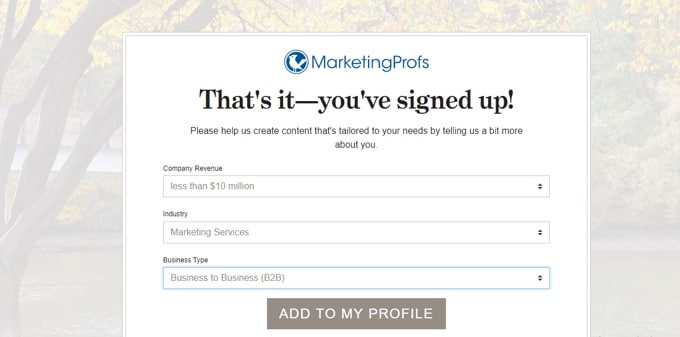
- Behavioral: Behavioral data is generated by tracking users’ online activities. Traffic source, page views, purchase behavior, app usage –all of these could be counted as raw behavioral data. In the case of behavioral segmentation, you divide your audience based on specific behavioral patterns( for example “users with the abandoned cart”).
Though demographic segmentation is far from being obsolete, the behavioural approach beats the demographic approach. The reason is, the behaviour is a far better indicator of user-intent. It makes sense to put two prospects from similar demographic backgrounds in different segments if their behaviors show different intent. However, the behavioural approach comes with the challenge of drawing the right conclusions. Unlike demographics segmentation which is straightforward, behavioral data is indecipherable in its raw form. You need a pair of experienced eyes to connect the right dots.
Google analytics dashboard, email automation analytics, heat maps — dashboards are the best sources of collecting behavioral data.
- Psychographic: Psychographic segmentation divides customers based on their psychographic profiles— lifestyle, attitude, political beliefs, etc. Interestingly, psychographic profiling probably most challenging but offers accurate personalization that actually feels personal. Allow me to give an example.
Think you have two prospects. One is a 24-year-old lady who is from NY, social media influencer, vegan and liberal. Another one is a 35-year-old gentleman from central China, techie and moderate. You almost want to place them in different segments, right?
Hold your horses!
What if they both are very concerned about environmental issues and insist on using low carbon footprint products?
Such similarity may not be noticeable but it could make a difference. You would be on both of their radars by just showing your brand is environmentally conscious too. So based on their preference they belong to the same segment.
Collecting psychographic data is a bit tricky. You get your hands on it by applying “filters” on behavioral data you collected.
These filters could be inductive in nature, like psychology principles and best practices. Alternatively, new patterns could emerge like vegans being more interested in fitness tech products.
Apart from these, sometimes social media analytics also provides some insights about users’ interests and attitudes. Last but not least, there are goldmines like Reddit and niche forums. If your audience is on the internet, there will be related forums. The questions asked and discussed on those forums are the free tickets to your users’ minds.
How to come up with personalization ideas
Once you are ready to venture deep into the realm of personalization, you need a couple of ideas, to begin with for each segment. Fear not, you can always discard or modify your ideas later on.
The best personalization ideas come from audience data. The quality of data impacts the effectiveness of your message.
Here is a brief discussion on how to come up with great personalization ideas.
Deductive research-based personalization ideas:
The deductive approach in personalization is all about developing personalization ideas based on a theory first. This theory could be anything– user intent, psychological principles, Industry best practices and more. Once you pick your theory, you want to generate personalization ideas based on that.
Once you have your ideas, your next goal should be testing the effectiveness of your idea.
Depending on the results, either you can stick to current ways or completely ditch those.
Inductive research-based personalization ideas
Inductive personalization ideas come from analyzing your existing customer data. If you have a decent business for a while, sometimes new audience segments and preferences come out of the woodwork. You would see a pattern on inspection.
Asos, an e-com clothing store is doing inductive personalization right. In late 2018, they introduced p-interest style boards where users can pin items they fancy.
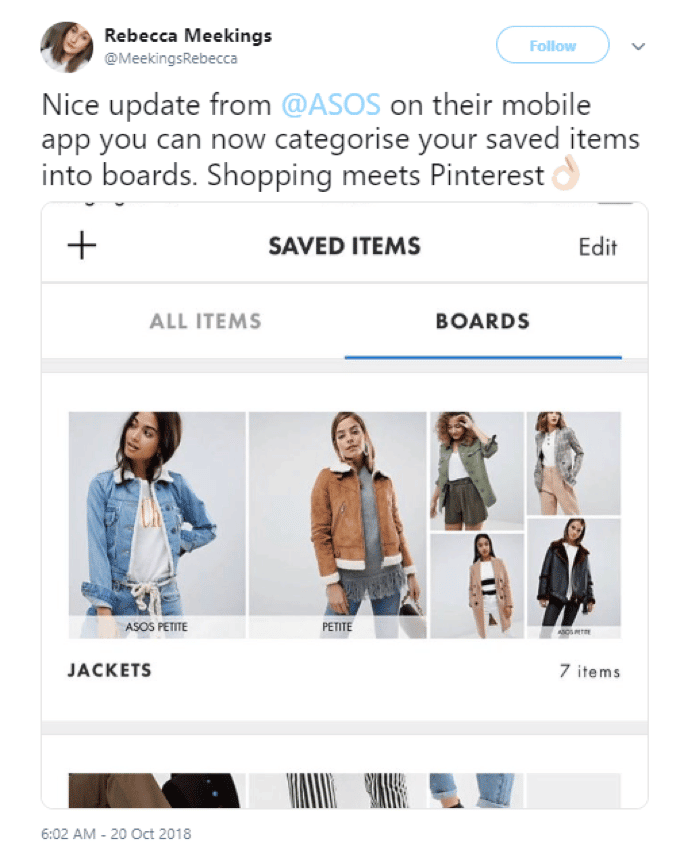
ASOS sends personalized product recommendations and deals to their users based on those curated items
Self-selected personalization
Sometimes asking customers what they want is the best course of action. After all, your customers know themselves best.
Unfortunately, only 37% of B2C marketers take time to talk with their customers.
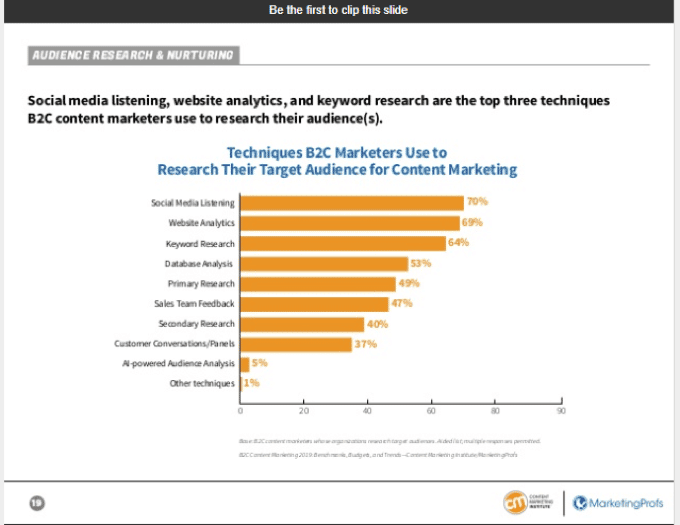
If done correctly, customers selected personalization is very powerful. When Class Tag introduced a self segmentation option on their site, their conversion increased 150%. Such stories are not unheard of.
Asking your users what they have in their mind is pretty straight forward. You can ask them right after they land on your website. Once they identify themselves, feel free to send personalized results. Salesforce follows this path.
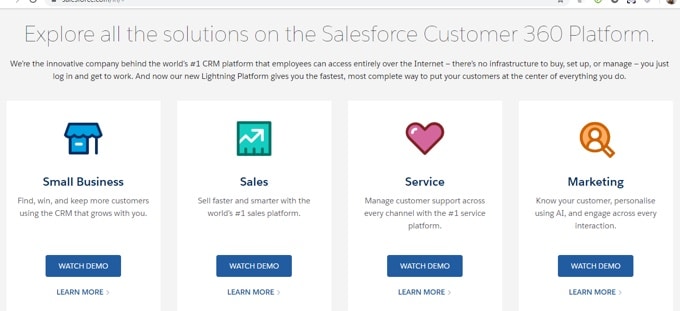
Alternatively, use chatbots conversation to understand their needs. Ask them what they want and segment them based on their preferences. Later you can personalize emails and websites according to the segment.
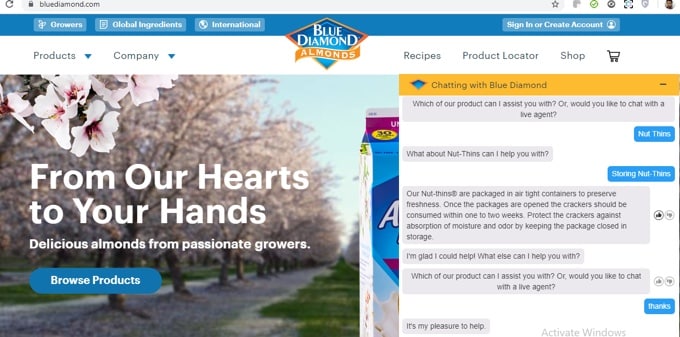
Take the example of Blue Diamond. Instead of guessing they ask the customer directly what he/she is looking for.
How to implement personalization ideas in practice
There are thousands of ways to personalize depending on your segment and goals. However, you can always take note of some creative and proven ways of doing things.
Want to know how to get started?
Let’s dive in.
Email personalization
Email is one of the best mediums for delivering content to audience segments. According to CampaignMonitor, personalized emails generate 760% more revenue and increases the open rate by 26%.
No wonder, 77% of marketers use emails for personalization. And you would be leaving money on the table if you aren’t doing email personalization yet.
With that said, gone are the days when just using the recipient’s name in the subject line was enough. You must to go deeper into customers’ minds and amaze them.
Personalize your company emails
Most brands just scratch the surface of the huge user data they have. Their personalized effort stop at writing emails based on user demographic data and sending product recommendations based on users’ purchase history.
Yes, demographic data and purchase history have their places. However, you would be better served if you dive deeper to tap into more personal user data. You don’t have to go full Sherlock holmes. Just pay attention to their habits or how often they use your product and you would find new ways to personalize that feels actually personal.
Take the example of Grammarly. I always prefer checking promotional emails after midnight. I skip those emails during other times of the day and many never get opened. Grammarly paid attention and here is the email I got. Take a look at the timestamp.
It is at 12.42 AM.
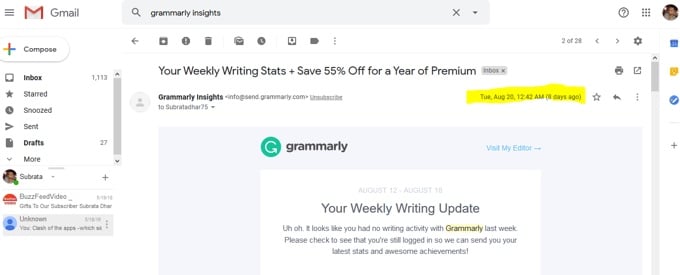
This is an excellent example of doing personalization right without being creepy. It’s subtle yet makes a huge difference in the long run.
Grammarly also uses users’ behavioral data to craft personalized content through email. They send stats about your productivity and how that stacks up against others.
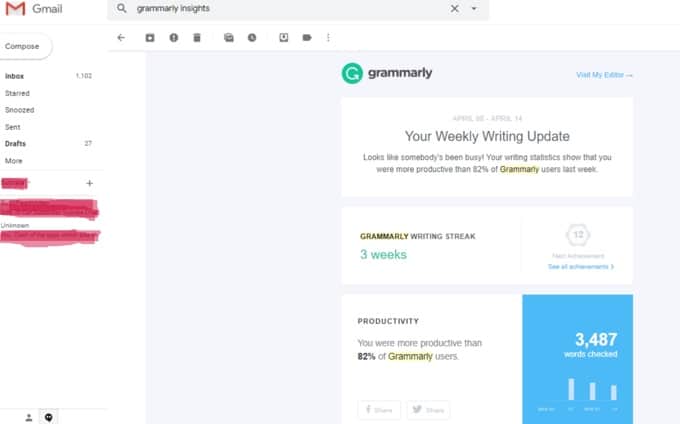
That’s some individual-level personalization that puts smiles on users’ faces.
Pretty cool, right?
Send more personalized cart abandonment emails
Cart abandonment is very common — 75% of customers have done it. However, that does not mean the sale is lost. According to the Sale cycle blog report, 44% of cart abandonment emails get opened and 29.% of clicks on those emails lead to purchase.
Effective cart abandonment emails re-engage users by offering useful content and making purchase real easy.
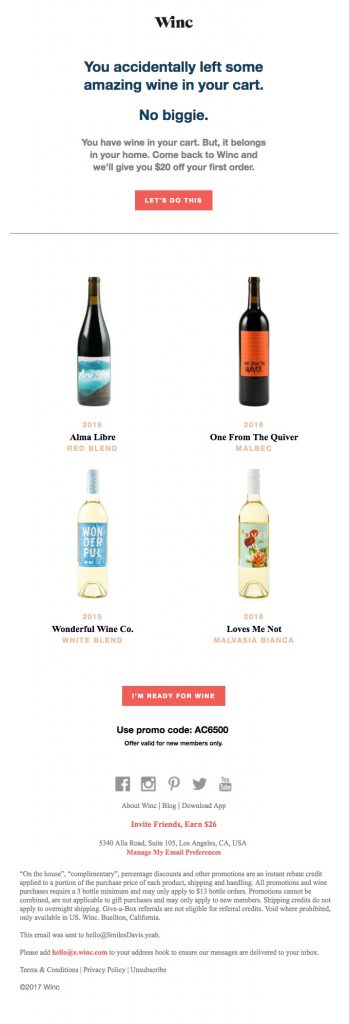
In this email, Winc gently reminded the customers they didn’t purchase the wine yet. They offered a $20 discount on top of that as well. This would make it easy for the recipient to purchase from the brand.
Additionally, there are links to other items based on recipients’ choices. Chances are good, the customers would add another item to the cart as well.
Website personalization
74% of visitors get frustrated when the website content doesn’t match with their interests. That’s why it’s important to provide a tailored experience to each visitor. And the best personalizations help to accomplish whatever goal the user has in his mind.
When done correctly website personalization can prove to be extremely effective. For example, 89% of marketers reported website personalization increased their revenue.
Long story short, your website is a powerful personalization medium. Better take advantage of it.
You can personalize virtually every aspect of your site. However, the following are the most impactful ones.
Personalized content
The intent of your website’s visitors varies widely. Some just stop by to read blog posts. Some are just there to hit the purchase button.
By personalizing your website content according to user intent, you help them to get the value at minimal effort. In other words, personalization boosts customer satisfaction.
There are two ways to offer personalized website content. First, segment your users according to their interest ( deductive approach) and create separate content (for example blog, landing pages, and case studies) for each segment.
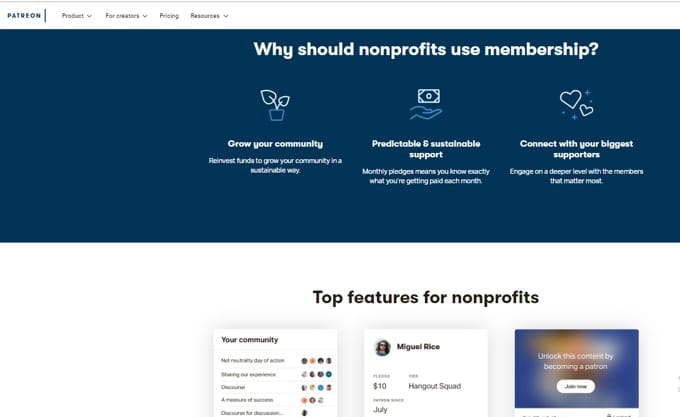
Patreon has segmented their audience according to the art or content they produce. If you click on “for creators” drop-down, you would be directed targeted landing pages for every segment. Here is a screenshot from their “non-profit creators” page.
Another way of content personalization is individual-level personalization. Does your customer prefer a specific kind of content? Serve them what they crave. Take a note from Netflix. The recommendations are entirely based on what the viewer watches.

Product and offer personalization
Unlike business sites, e-commerce sites have more visitors with buying intent than educational intent. Visitors land on e-com sites to mostly browse the products and purchase. It makes more sense for e-com stores to offer personalized experience by showcasing products instead of recommending blog posts. Even 80% of shoppers actively want it.
If you are wondering where to start, take a look at your users’ browsing and purchase history. Do they take a special interest in some specific products? Feel free to push similar products before them.
You can also try cross-selling as well. Sometimes many customers with similar interests buy two or more products as a bundle. Pushing those items under a “people also buy ” section can result in more sales.
Amazon is good at personalizing the home page.
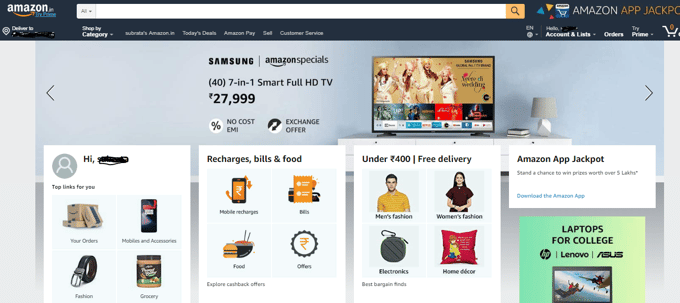
How to measure effectiveness and prioritize personalization ideas.
Ever heard of any swimming competition where no one records the timing of the participants? Or any written test without any marking or grade system?
No, right? Because in order to compare one needs to measure the changes.
Personalization is no exception. Some of your assumptions would not move the needle, others might make a day and night difference. In order to find out the extent of the effectiveness of ideas, you require a framework in place.
Without further ado, here is how to measure personalization to reveal your progress.
Define your goals: Personalization starts from defining your goals. What do you want to accomplish? Is it more traffic on your site? More revenue?
Depending on your business, industry, and resources goals can vary. Here are a few more examples to give you a better idea:
- Increasing the conversion rate.
- Boosting sales numbers.
- Driving more traffic to the blog
- Increasing the customer’s lifetime value.
While setting your goals, remember two things: first, your goals should be tangible. For instance, generating more traffic is a vague goal. Increasing traffic before Halloween through Instagram is a realistic one.
Second, don’t set more than a handful of goals at a time. Each goal might require multiple A/B testing. If you are chasing 20 different goals at a time, you are spreading yourself thin and getting nowhere.
Get the right metrics: metrics are your yardstick. And you need to find the right ones according to the goal. Let me give you an example. Suppose your goal is to reduce cart abandonment using personalized emails. In that case, you would be tracking metrics like email open rate and click-through rate.
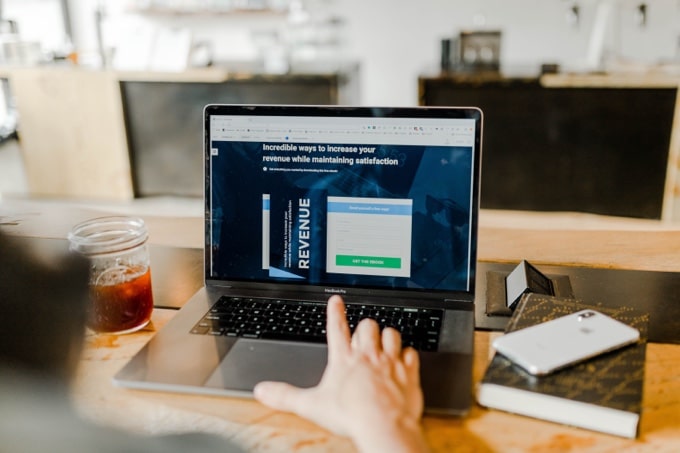
Though KPIs can vary depending on the goals, a handful of pivotal KPIs always makes their way to most of the experiments. Here is a brief introduction to the most important ones:
Average Order Value: Simply put, it calculates how much an average customer spent each time they make a purchase. Usually, AOV and revenue are positively correlated (provided conversion rate constant or increasing).
Conversion rate: It’s a ratio of the number of actions taken vs total visitors. A high conversion rate also indicates more revenue if they are enough volume of conversion.
Revenue per visitor: This is the measurement of how much revenue is generated whenever a customer visits your site. In other words, this is the ratio of total revenue and the total number of visitors.
Measure: Once you have the right KPIs, roll up your sleeves and start crunching numbers. This is when attention to detail and the right tools make all the differences. It’s on your team to look only for numbers that matter. For example, Google Analytics generates over 70 different reports. Only a pair of experienced eyes can pick out the relevant reports and discard the rest.
Next comes the question, how long you should be running your tests for? Well, on an average sweet spot lies between a minimum of one week to a maximum of four weeks.
Once you get the complete picture of how things are working out, decide what changes you want to keep. Sometimes you may have to prioritize one change to another. In such situations be biased to the changes that support your pressing goals.
Conclusion
Effective personalization requires customer data, ideation, and an effective validation process. Not easy, but it is worth it. Once you manage to make your customers special, they would return it multifold.



